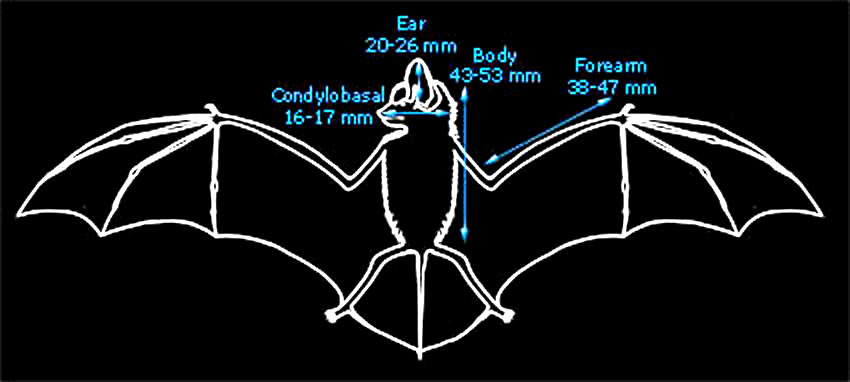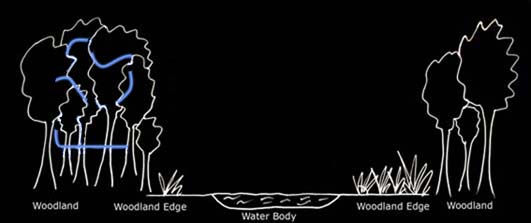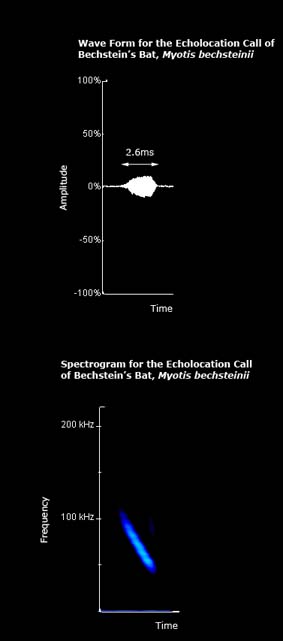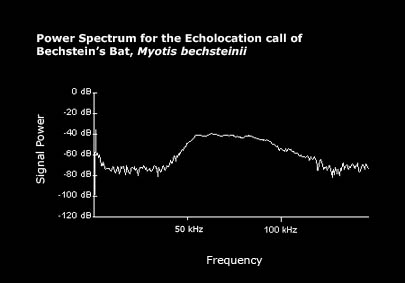Morphological Description
Life History
Distribution
Habitat
Roost Sites and Roosting Patterns
Emergence and Flight Pattern
Foraging Behaviour
Echolocation Calls
Status and Protection |
|
|
Morphological Description
- Dorsal fur is pale brown. Ventral fur is light grey to white.
- Juveniles are light grey.
- Ears are longer than 18mm but significantly shorter than those of the brown and grey long-eared bats, which are over 28mm (Stebbings, 1991).
- Adult males have a short, blunt penis.
- Average weight (as given by Greenaway & Hutson, 1990) 7-13 g.
The diagram below gives important average body measurements for Bechstein's bats (Greenaway & Hutson, 1990).
|

Back to top |
Life History
- Mate from autumn to spring.
- Bechstein's bats give birth to one offspring towards the end of June or the beginning of July.
- Maximum age recorded in Europe is 21 years (Schober & Grimmberger, 1989).
Back to top
|
Distribution |
|
|
 |
| The British and World distributions are shown by the white areas of the maps above (as given by Richardson, 2000 and Corbet & Harris, 1991 respectively). |
|
Rare throughout Britain, mainly found in central south England.
Back to top
|
Habitat |
|
- Found in both low and high damp, mainly deciduous woodland.
- Occasionally found in parkland and coniferous woodland.
- Vaughan et al. (1997) found that Myotis bats inhabited a wide range of habitats, particularly rivers and lakes, but were never in villages.
- The photograph on the left shows a typical habitat of Bechstein's bats.
|
| Roost Sites and Patterns |
- Summer roosts: tree holes.
- Winter roosts: hanging in exposed sites within caves, cellars and tree holes from March to April.
- Females are found in nursery roosts in groups of 10-30 individuals from April. Males are solitary during the summer.
Back to top
|
Emergence and Flight Pattern |
- Median emergence time is 33 minutes after sunset (Jones & Rydell, 1994).
- Flies up to 15m above ground level but normally lower (Stebbings, 1991a).
- Flight is slow and fluttering but extremely agile.
Back to top
|
Foraging Behaviour |
|
Forages largely in enclosed vegetation whilst flying low.
The diet of Bechstein's bats mainly consists of Lepidoptera (including tympanate Noctuidae) and crepuscular and diurnal Diptera (Vaughan, 1997).
Safi & Kerth (2004) found that Bechstein's bats consume mainly Dermaptera (20.3%) and Lepidoptera (18.1%). In contrast to previous suggestions Safi & Kerth (2004) found that bats with a high dietary specialisation do not appear to be more vulnerable to extinction than species with a wide dietary niche. Instead wing morphology, which is often a sign of habitat specialization, could indicate the vulnerability of a species.
Prey is caught and consumed during flight or gleaned off the ground of tree trunks.
|
 |
|
Marked in blue on the diagram above is a typical foraging path of Bechstein's bats (based on Russ, 1999).
Back to top
|
Echolocation Calls |
|
|
|


|
The echolocation call of Bechstein's bats is frequency modulated. |
|
To listen to the call of the Bechstein's bat click here
Size of sound file: 9.29 KB
|

|
| For details of how the echolocation calls were recorded click here. |
|
Average values for a Bechstein's bat echolocation call, as given by Vaughan et al. (1997), are listed below:
Interpulse interval: 96.4ms
Call duration: 2.54ms
Minimum frequency: 33.8kHz
Maximum frequency: 111.0kHz
The spectrogram on the left shows clear frequency modulation, with the call beginning at high frequency and ending at a lower frequency.
The power spectrum on the left shows that the maximum power of the call is at a frequency of approximately 50 kHz.
|
Back to top
|
|
| Status and Protection
- Fairly widespread but has become very rare in Britain.
- The British pre-breeding population was estimated at 1500 in 1995 (all in England, may be additional populations in Wales ) (Harris et al., 1995).
- The worldwide IUCN status (2001) for Bechstein's bats is Vulnerable.
- Bechstein's bat is now very rare in the UK. However at the Neolithic site of Grimes Graves, Norfolk and at a site in Kent , Bechstein's bat was found to be the most common species (Yalden, 1992). The decline in the number of Bechstein's bats since the Neolithic age has been attributed to the decline of suitable woodland habitat in the UK.
- Although Bechstein's bats may be one of the rarest mammal species in Britain, unexpectedly high numbers were caught at underground sites by Parsons et al. (2003). Bechstein's bats are rarely, if ever, found hibernating in underground sites. This indicates that the Bechstein's bats caught at the swarming sites in this study may travel long distances to these sites exclusively for swarming. Additionally, swarming is likely to have an important reproductive function, and so it is essential to conserve swarming sites. In response to this study two of the swarming sites have been selected as candidate Special Areas of Conservation (cSAC) for barbastelle and Bechstein's bats.
- Safeguarding of roost sites, especially old trees, and erection of bat boxes can be used to help maintain existing populations.
Back to top
|
 © School of Biological Sciences, University of Bristol 2005. Last modified 24th February 2005. © School of Biological Sciences, University of Bristol 2005. Last modified 24th February 2005. |




 © School of Biological Sciences, University of Bristol 2005. Last modified 24th February 2005.
© School of Biological Sciences, University of Bristol 2005. Last modified 24th February 2005.